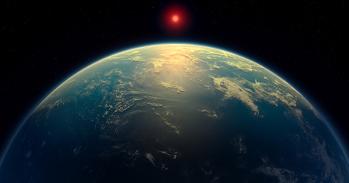An international team of astronomers has found a system of seven potentially habitable planets orbiting a star 39 light years away three of which could have water on their surfaces raising the possibility they could host life. Using ground and space telescopes, the team identified the planets as they passed in front of the ultracool dwarf star known as TRAPPIST-1. The star is around eight per cent of the mass of the Sun and is no bigger than Jupiter.
An international team of astronomers has found a system of seven potentially habitable planets orbiting a star 39 light years away three of which could have water on their surfaces raising the possibility they could host life. Using ground and space telescopes, the team identified the planets as they passed in front of the ultracool dwarf star known as TRAPPIST-1. The star is around eight per cent of the mass of the Sun and is no bigger than Jupiter.
That the planets are so similar to Earth bodes well for the search for life elsewhere
Amaury Triaud
The team has been using the TRAPPIST–South telescope at the European Southern Observatory’s (ESO) La Silla Observatory, the Very Large Telescope (VLT) at Paranal, the NASA Spitzer Space Telescope as well as two other telescopes supported by the UK’s STFC, the William Herschel Telescope and the Liverpool Telescope. All the planets, labelled TRAPPIST-1b, c, d, e, f, g and h in order of increasing distance from their parent star, have sizes comparable to Earth.
The astronomers identified the planets thanks to periodic drops in the brightness of the central star. As the planets passed in front of the star, they cast a shadow, events known as transits, from which the team could measure the planet’s orbital periods and calculate their sizes and masses. They found that the inner six planets were comparable in size, mass and temperature to the Earth raising the possibility that they host liquid water on their surface.
With just 8% the mass of the Sun, TRAPPIST-1 is very small in stellar terms, only marginally bigger than the planet Jupiter — and though nearby in the constellation Aquarius, it is invisible visually with anything less than powerful telescopes. Astronomers expected that such dwarf stars might host many Earth-sized planets in tight orbits, making them promising targets in the hunt for extraterrestrial life. TRAPPIST-1 is the first such system to be discovered.
Co-author Dr Amaury Triaud, of the University of Cambridge’s Institute of Astronomy, explains: “Stars like TRAPPIST-1 belong to the most common type of stars that exist within our Galaxy. The planets that we found are likely representative of the most common sort of planets in the Universe.
“That the planets are so similar to Earth bodes well for the search for life elsewhere. Planets orbiting ultra-cool dwarfs, like TRAPPIST-1, likely represent the largest habitable real estate in the Milky Way!”

The seven planets of the TRAPPIST-1 system. Credit: ESO
The team determined that all the planets in the system were similar in size to Earth and Venus in our Solar System, or slightly smaller. The density measurements suggest that at least the innermost six are probably rocky in composition.
The planetary orbits are not much longer than that of Jupiter’s Galilean moon system, and much smaller than the orbit of Mercury in the Solar System. However, TRAPPIST-1’s small size and low temperature means that the energy input to its planets is similar to that received by the inner planets in our Solar System; TRAPPIST-1c, d and f receive similar energy inputs to Venus, Earth and Mars, respectively.
All seven planets discovered in the system could potentially have liquid water on their surfaces, though their orbital distances make some of them more likely candidates than others. Climate models suggest the innermost planets, TRAPPIST-1b, c and d, are probably too hot to support liquid water, except maybe on a small fraction of their surfaces. The orbital distance of the system’s outermost planet, TRAPPIST-1h, is unconfirmed, though it is likely to be too distant and cold to harbour liquid water — assuming no alternative heating processes are occurring. TRAPPIST-1e, f, and g, however, are of more interest for planet-hunting astronomers, as they orbit in the star’s habitable zone and could host oceans of surface water.
These new discoveries make the TRAPPIST-1 system an even more important target in the search for extra-terrestrial life. Team member Didier Queloz, from the University of Cambridge’s Cavendish Laboratory, is excited about the future possibilities: “Thanks to future facilities like ESO’s Extremely Large Telescope, or NASA/ESA’s soon-to-be-launched James Webb Space telescope, we will be capable to measure the structure of the planets’ atmospheres, as well as their chemical composition. We are about to start the remote exploration of terrestrial climates beyond our Solar system.”
The discovery is described in Nature, which also includes a science fiction short story, written by Laurence Suhner. Amaury Triaud comments: “We were thrilled at the idea of having artists be inspired by our discoveries right away. We hope this helps convey the sense of awe and excitement that we all have within the team about the TRAPPIST-1 system.”
The star draws its name from the TRAPPIST-South telescope, which made the initial discovery. TRAPPIST is the forerunner of a more ambitious facility called “SPECULOOS” that includes Cambridge as core partner, conducted by researchers of the “Cambridge Centre for Exoplanet Research” in the broad research context related to “Universal Life”. SPECULOOS is currently under construction at ESO’ Observatory of Cerro Paranal. SPECULOOS will survey 10 times more stars for planets, than TRAPPIST could do. We expect to detect dozens of additional terrestrial planets.
Michaël Gillon et al: “Seven temperate terrestrial planets around the nearby ultracool dwarf star TRAPPIST-1” Nature 23rd Feb. 2017
http://www.nature.com/nature/journal/v542/n7642/full/nature21360.html
Link to a science-fiction short story: http://www.nature.com/nature/journal/v542/n7642/full/542512a.html
Cambridge Exoplanet Research Centre: http://exoplanets.phy.cam.ac.uk
For additional information, images, videos, a graphic novel and short stories, visit www.trappist.one
Adapted from a press release by the European Southern Observatory (ESO)

The text in this work is licensed under a Creative Commons Attribution 4.0 International License. For image use please see separate credits above.




